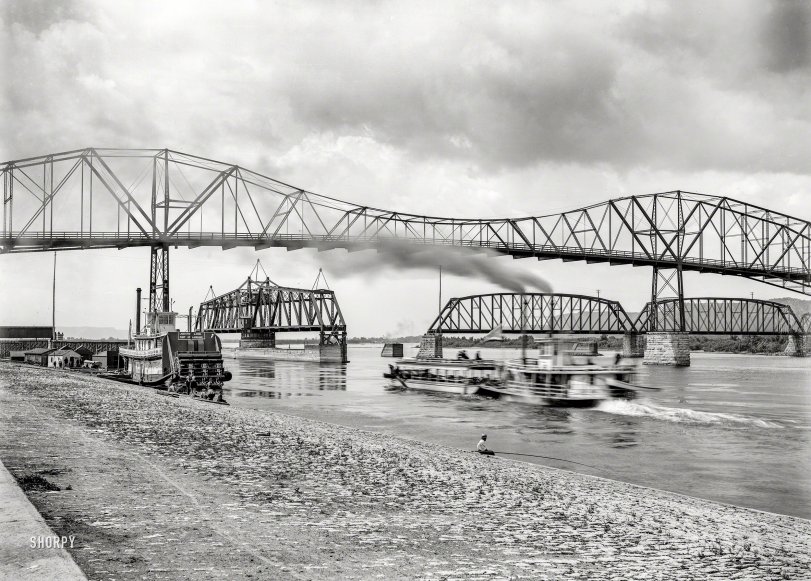


Framed or unframed, desk size to sofa size, printed by us in Arizona and Alabama since 2007. Explore now.
Shorpy is funded by you. Patreon contributors get an ad-free experience.
Learn more.

- Lofty addition
- In 1912
- Keenan Building
- Six years old
- Taken from the P.J. McArdle Roadway?
- It stood only 47 years
- Three track mind
- Incline to the right
- Reach for the sky, 1912 style
- No clean sweep
- Same Job Title, Same Face
- Sadly Lost
- Beautiful ...
- Where you get your kicks
- Aim High
- Pueblo Revival sisters
- Pueblo Neoclassicism
- Milk Man
- Regional dialect.
- Spielberg's inspiration
- Great Photo
- Loaf Story
- Do you still have the Rakes category?
- Could almost be a scene from the 1957 movie 'Hell Drivers'
- The Wages of Fear.
- Conspicuous by their absence
- Got Milk?
- All that aluminum
- No lefties
- Smoke 'em if you've got 'em
Print Emporium
River Traffic: 1898

The Mississippi River circa 1898. "Winona, Minnesota. The levee below the bridge." At left, the sternwheeler Lafayette Lamb. 8x10 inch dry plate glass negative, Detroit Photgraphic Company. View full size.
Clouds? Sky?
Just realized that the sky has clouds. Was this shot with panchromatic film?
[This wasn't shot with any kind of film. It's a glass plate negative. - Dave]
Period signage. Nice.
I think Dave would be absolutely miserable if confined to a language where all words have only one meaning.
Full stop?
Why do you suppose they put a period after "Lamb"?
[Period signage. - Dave]
Bridge Over Troubled Water
Two bridges can be seen in this photo. One had been around for more than 25 years. The other, much bigger, was pretty new at the time. From a 1960s report for the Interior Department, addressing both:
Although a railroad bridge connected Winona to the Wisconsin shore as early as 1871, the city had no direct highway access for another two decades. Teamsters made do with a ferry that carried them over the Main Channel to Latsch Island; there they disembarked onto a long wooden trestle that spanned the North Channel and the river's remaining expanse. In 1892, the ferry finally gave way to Bridge #5930, Steel, cantilever, through-truss design, the span was a municipally financed project designed to make Winona the main trade center for its Wisconsin neighbors. To retire the construction debt, the city administered the new "High Wagon Bridge" as a toll crossing.
By the 1930s, auto traffic was making the now "old" high bridge obsolete, with its zigzag connection to an older North Channel wagon bridge a serious impediment.
A new span was designed and survives today about a quarter mile up river from the bridges seen in the photo above. Ironically, an updated form of the original North Channel wagon bridge survives for non-motorized traffic.
Answered my own question
The Winona Bridge had a swing span
“The bridge was built from the Wisconsin shore across the back channel to Island 72, now known as Latsch Island, across the main channel to the Winona shore. In the middle of the channel, a huge stone pylon was built up from the riverbed, and a steel and wood beam span was built on top of it. This section of bridge was designed to pivot on that center support, swinging parallel to the shore to allow steamboats, barges and log rafts to pass unimpeded. A tender's shack stood at the pivot point to shelter the rail roadman, who set the machinery in motion to swing the bridge closed when a train approached. At 363 feet, its swinging span -- the "draw" -- was the longest in the world.”
https://www.winonadailynews.com/special-section/pieces-of-the-past/thurs...
























On Shorpy:
Today’s Top 5